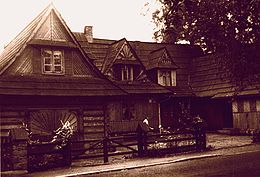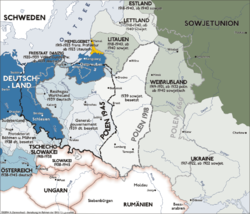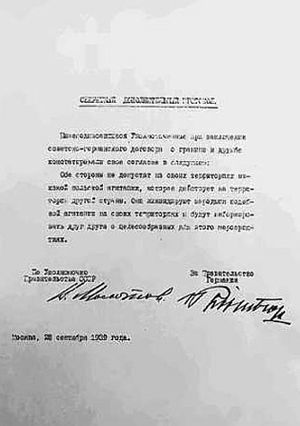
Gestapo-NKVD Conferences
Encyclopedia

Soviet-German cooperation
Soviet–German relations date to the aftermath of the First World War. The Treaty of Brest-Litovsk, ending World War I hostilities between Russia and Germany, was signed on March 3, 1918. A few months later, the German ambassador to Moscow, Wilhelm von Mirbach, was shot dead by Russian Left...
. In spite of several differences, both Heinrich Himmler
Heinrich Himmler
Heinrich Luitpold Himmler was Reichsführer of the SS, a military commander, and a leading member of the Nazi Party. As Chief of the German Police and the Minister of the Interior from 1943, Himmler oversaw all internal and external police and security forces, including the Gestapo...
and Lavrentiy Beria
Lavrentiy Beria
Lavrentiy Pavlovich Beria was a Georgian Soviet politician and state security administrator, chief of the Soviet security and secret police apparatus under Joseph Stalin during World War II, and Deputy Premier in the postwar years ....
had common purposes as far as the fate of Poland was concerned, and the conferences discussed coordinating plans for occupation of the Polish nation and in fighting the Polish resistance movement
Polish resistance movement in World War II
The Polish resistance movement in World War II, with the Home Army at its forefront, was the largest underground resistance in all of Nazi-occupied Europe, covering both German and Soviet zones of occupation. The Polish defence against the Nazi occupation was an important part of the European...
, which was an irritant to both Nazi
Nazi Germany
Nazi Germany , also known as the Third Reich , but officially called German Reich from 1933 to 1943 and Greater German Reich from 26 June 1943 onward, is the name commonly used to refer to the state of Germany from 1933 to 1945, when it was a totalitarian dictatorship ruled by...
and Soviet
Soviet Union
The Soviet Union , officially the Union of Soviet Socialist Republics , was a constitutionally socialist state that existed in Eurasia between 1922 and 1991....
occupiers of Poland.
Out of four conferences, the third took place in the famous Tatra Mountains
Tatra Mountains
The Tatra Mountains, Tatras or Tatra , are a mountain range which forms a natural border between Slovakia and Poland, and are the highest mountain range in the Carpathian Mountains...
spa of Zakopane
Zakopane
Zakopane , is a town in southern Poland. It lies in the southern part of the Podhale region at the foot of the Tatra Mountains. From 1975 to 1998 it was in of Nowy Sącz Province, but since 1999 it has been in Lesser Poland Province. It had a population of about 28,000 as of 2004. Zakopane is a...
in Poland, and is the most remembered (the Zakopane Conference). From the Soviet side, several officers of the NKVD
NKVD
The People's Commissariat for Internal Affairs was the public and secret police organization of the Soviet Union that directly executed the rule of power of the Soviets, including political repression, during the era of Joseph Stalin....
participated in these meetings, and the Germans brought a group of experts from the Gestapo
Gestapo
The Gestapo was the official secret police of Nazi Germany. Beginning on 20 April 1934, it was under the administration of the SS leader Heinrich Himmler in his position as Chief of German Police...
.
Prelude

Soviet invasion of Poland (1939)
The 1939 Soviet invasion of Poland was a Soviet military operation that started without a formal declaration of war on 17 September 1939, during the early stages of World War II. Sixteen days after Nazi Germany invaded Poland from the west, the Soviet Union did so from the east...
on 17 September resulted in the country being occupied by the Soviet Union and Nazi Germany.
First Conference
Little is known about this meeting. It reportedly took place on September 27, 1939 in Brzesc nad Bugiem, while some units of the Polish Army were still fighting (see: Invasion of PolandInvasion of Poland (1939)
The Invasion of Poland, also known as the September Campaign or 1939 Defensive War in Poland and the Poland Campaign in Germany, was an invasion of Poland by Germany, the Soviet Union, and a small Slovak contingent that marked the start of World War II in Europe...
). As both sides correctly expected that Polish resistance would start soon, they discussed ways of dealing with the possible activities of such resistance.
Second Conference
It took place some time at the end of November 1939, probably in PrzemyślPrzemysl
Przemyśl is a city in south-eastern Poland with 66,756 inhabitants, as of June 2009. In 1999, it became part of the Podkarpackie Voivodeship; it was previously the capital of Przemyśl Voivodeship....
— a city which—between September 1939 and June 1941—was divided into two parts, German and Soviet. Apart from talks of fighting Polish resistance, the Soviets and the Germans discussed ways of exchanging Polish POWs. Also, first discussions about the occupation of Poland were started. Some historians claim this meeting took place in Lviv
Lviv
Lviv is a city in western Ukraine. The city is regarded as one of the main cultural centres of today's Ukraine and historically has also been a major Polish and Jewish cultural center, as Poles and Jews were the two main ethnicities of the city until the outbreak of World War II and the following...
. It is also claimed a meeting was held in December.

Third Conference
This one is the best known, and took place in ZakopaneZakopane
Zakopane , is a town in southern Poland. It lies in the southern part of the Podhale region at the foot of the Tatra Mountains. From 1975 to 1998 it was in of Nowy Sącz Province, but since 1999 it has been in Lesser Poland Province. It had a population of about 28,000 as of 2004. Zakopane is a...
, starting on February 20, 1940 in the villa "Pan Tadeusz", located on the road from Zakopane to Białka Tatrzańska. The German side was represented by Adolf Eichmann
Adolf Eichmann
Adolf Otto Eichmann was a German Nazi and SS-Obersturmbannführer and one of the major organizers of the Holocaust...
and an official by the name of Zimmermann, who later became chief of the Radom District of the General Government
General Government
The General Government was an area of Second Republic of Poland under Nazi German rule during World War II; designated as a separate region of the Third Reich between 1939–1945...
. The Soviets brought—among others—Rita Zimmerman (director of a gold mine in Kolyma
Kolyma
The Kolyma region is located in the far north-eastern area of Russia in what is commonly known as Siberia but is actually part of the Russian Far East. It is bounded by the East Siberian Sea and the Arctic Ocean in the north and the Sea of Okhotsk to the south...
) and a man named Eichmans, creator of an efficient way of killing in the back of the head.
According to several sources, one of the effects of this conference was the German 'Ausserordentliche Befriedungsaktion (see: German AB Action operation in Poland), elimination of Krakow inteligentia Sonderaktion Krakau
Sonderaktion Krakau
Sonderaktion Krakau was the codename for a German operation against professors and academics from the University of Kraków and other Kraków universities at the beginning of World War II....
and the Soviet Katyn massacre
Katyn massacre
The Katyn massacre, also known as the Katyn Forest massacre , was a mass execution of Polish nationals carried out by the People's Commissariat for Internal Affairs , the Soviet secret police, in April and May 1940. The massacre was prompted by Lavrentiy Beria's proposal to execute all members of...
(a number of historians, including Norman Davies
Norman Davies
Professor Ivor Norman Richard Davies FBA, FRHistS is a leading English historian of Welsh descent, noted for his publications on the history of Europe, Poland, and the United Kingdom.- Academic career :...
, claim that these two events were carried out cooperatively). This is disputed by numerous historians (see below).
News about the conference must have leaked out to Great Britain
Great Britain
Great Britain or Britain is an island situated to the northwest of Continental Europe. It is the ninth largest island in the world, and the largest European island, as well as the largest of the British Isles...
, but London
London
London is the capital city of :England and the :United Kingdom, the largest metropolitan area in the United Kingdom, and the largest urban zone in the European Union by most measures. Located on the River Thames, London has been a major settlement for two millennia, its history going back to its...
did not seem to care, which was immediately noticed by Joseph Stalin
Joseph Stalin
Joseph Vissarionovich Stalin was the Premier of the Soviet Union from 6 May 1941 to 5 March 1953. He was among the Bolshevik revolutionaries who brought about the October Revolution and had held the position of first General Secretary of the Communist Party of the Soviet Union's Central Committee...
. Also, most probably in Zakopane, the Germans rejected suggestions of the Soviets to take over Polish officers, which sealed their fate. On March 5, 1940, in Moscow
Moscow
Moscow is the capital, the most populous city, and the most populous federal subject of Russia. The city is a major political, economic, cultural, scientific, religious, financial, educational, and transportation centre of Russia and the continent...
, the decision was made to murder them.
In his 1991 book Stalin: Breaker of Nations, British historian Robert Conquest
Robert Conquest
George Robert Ackworth Conquest CMG is a British historian who became a well-known writer and researcher on the Soviet Union with the publication in 1968 of The Great Terror, an account of Stalin's purges of the 1930s...
stated: "Terminal horror suffered by so many millions of innocent Jewish, Slavic, and other European peoples as a result of this meeting of evil minds is an indelible stain on the history and integrity of Western civilization, with all of its humanitarian pretensions". Also, professor George Watson from Cambridge University concluded in his "Rehearsal for the Holocaust?" Commentary (June 1981) that the fate
Katyn massacre
The Katyn massacre, also known as the Katyn Forest massacre , was a mass execution of Polish nationals carried out by the People's Commissariat for Internal Affairs , the Soviet secret police, in April and May 1940. The massacre was prompted by Lavrentiy Beria's proposal to execute all members of...
of the interned Polish officers may have been decided at this conference.
Both Russian and Polish historians dispute the connection between the German-Soviet meetings and the Katyn massacre. They point out that there is no documentary evidence confirming any cooperation on that issue, that the existing Soviet documentation actually makes such a cooperation improbable and that it is reasonable to say that Germany did not know about the Katyn massacre until the corpses were found. Specifically, historian Oleg Vishlyov points out that the alleged third conference in Zakopane in 1940 is not proven by any known German or Soviet documents and its description is only based on Bor-Komorowski's claims.
Fourth Conference
The fourth and last meeting took place in March 1940 in KrakowKraków
Kraków also Krakow, or Cracow , is the second largest and one of the oldest cities in Poland. Situated on the Vistula River in the Lesser Poland region, the city dates back to the 7th century. Kraków has traditionally been one of the leading centres of Polish academic, cultural, and artistic life...
(according to some historians, it was part of the Zakopane Conference). This event was described by General Tadeusz Bór-Komorowski
Tadeusz Bór-Komorowski
General Count Tadeusz Komorowski , better known by the name Bór-Komorowski was a Polish military leader....
, commander of Armia Krajowa
Armia Krajowa
The Armia Krajowa , or Home Army, was the dominant Polish resistance movement in World War II German-occupied Poland. It was formed in February 1942 from the Związek Walki Zbrojnej . Over the next two years, it absorbed most other Polish underground forces...
in his book “Armia Podziemna” (“The Secret Army”). In it, he describes how a special delegation of NKVD came to Krakow, which was going to discuss with Gestapo how to act against the Polish resistance. The talks lasted for several weeks.
One of the ways of fighting Polish organized resistance in the German occupied General Government
General Government
The General Government was an area of Second Republic of Poland under Nazi German rule during World War II; designated as a separate region of the Third Reich between 1939–1945...
was creation of communist organizations (such as "Hammer and Sickle" or "Association of Friends of Soviet Union"), overseen by Moscow. Left-wing activists were cooperating with the NKVD, passing to them information about Polish patriotic groups. The Soviets then handed these reports to the Gestapo.
Bor-Komorowski′s description is disputed by Russian historian Oleg Vishlyov, who, based on the original Soviet documents, points out that the conference was not between NKVD and Gestapo, but between Soviet and German commissions dealing with refugees. The topic of discussion was refugee exchange. The conference has nothing to do with repressions against Poles or with the Katyn massacre. In fact, numerous historians point out that there is no evidence of German-Soviet cooperation in the Katyn massacre.
Further reading
- Bor-Komorowski, Tadeusz (1951). "The Secret Army". New York, N.Y.: Macmillan. OCLC: 1524738

